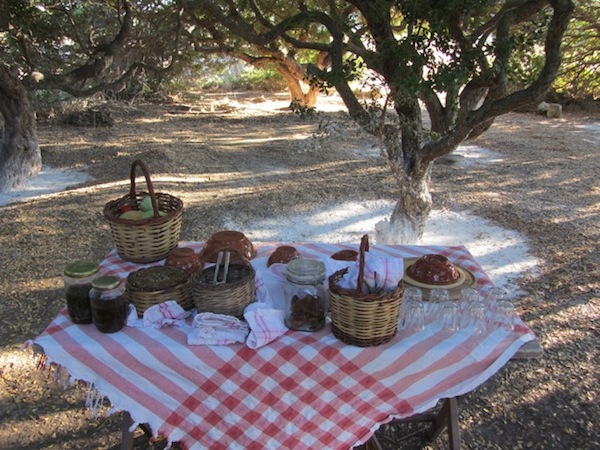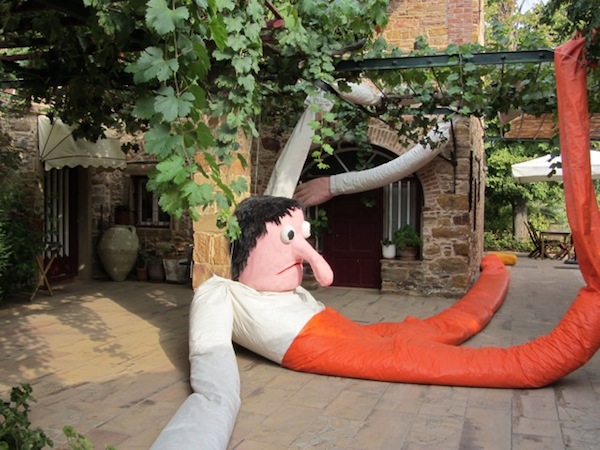Chios Dreams—Looking On The Bright Side
“Eating Well Is The Best Revenge”
by Diana Farr Louis
 ANDROS Greece—(Weekly Hubris)—9/12/2011—The Greeks have a saying about their countrymen from the island of Chios in the northeast Aegean. “The Chiots go about in pairs, two by two,” they’ll pronounce with a slightly mocking tone, as if to imply that in this land of ruthless individualism reliance on another signifies weakness.
ANDROS Greece—(Weekly Hubris)—9/12/2011—The Greeks have a saying about their countrymen from the island of Chios in the northeast Aegean. “The Chiots go about in pairs, two by two,” they’ll pronounce with a slightly mocking tone, as if to imply that in this land of ruthless individualism reliance on another signifies weakness.
Few outsiders, though, know where the saying comes from.
It seems that in the days of the Ottoman Empire, when Chios was the jewel in the Sultan’s turban, some resentful Turks yearned to taunt the islanders. But opportunities were rare. Being property owners or mastic growers, they had a privileged status. So an unwritten rule evolved that whenever a Turk encountered a Greek on the road, he could oblige the infidel to carry him.
The Greeks therefore circulated in pairs, so that one could hop upon the other’s back should a bullying Turk appear in the distance. Better to carry your friend than be humiliated by a stranger.
I’m listening to this explanation in a mastic grove outside the medieval village of Mesta in southern Chios. The trees belong to Vassilis Ballas, who runs a small ecotourism agency from a vaulted basement office in the main square. Vassilis and his wife, Roula Bouras, are refugees from Athens. On the spur of the moment, when weather turned a winter holiday weekend into a longer stay in 2006, they decided to quit their jobs with an IT company and move to Chios.
They would take over Vassilis’s grandmother’s mastic trees, buy some more, and get back to nature. Then 31, they soon discovered that tending the trees and collecting and cleaning the resin were both backbreaking and mindshrinking. Simple tasks took forever until they learned the knack, and then they were fun but not for more than a couple of hours at a time.
Luckily, they didn’t have to go it alone. Mastic culture is a cooperative venture. The average tree yields about 200 grams of crystallized resin, which sells for up to 80 euros a kilo before becomes an ingredient in chewing gum, Turkish delight, ice cream, liqueur, baked goods, cosmetics, even incense. You’d need to have 3,000 trees in order to justify paying help. So, usually, it’s a family affair.
Roula and Vassilis have made an arrangement with their koumbaros Nikos, another ex-Athenian office worker. Inadequately translated as best man or groom’s man, a koumbaros is a lifetime bond, someone you can trust in sickness and in health. Nikos and his father Yiorgos, who started working in the mastic fields when he was 8, share the labor and the harvest, freeing Vassilis to follow his dream.
Under the dappled shade of his elegant but twisted mastic trees, Vassilis initiates a group of visitors into the mysteries of this ancient spice, whose healthful properties have been known since Dioscurides invented pharmacology during Nero’s reign. Though the tree is related to the pistachio and the common lentisk, Greece’s horribly invasive schinos bush, which is threatening to choke some of our olive trees on Andros, it doesn’t ooze its aromatic resin in marketable quality or quantity anywhere except southern Chios.
In Chios to research an article on mastic for the Art of Eating, I’ve spent the morning with Nikos and his father on a rough and rocky hillside. There the stubby, gnarled trees have little of the glamor of Vassilis’s grove. But as he says, “What tourist is going to get up at 5 and follow them? Here I can show anyone interested the essentials in relative comfort, give them insight into a way of life that has hardly changed in two thousand years. It’s something I always wanted when I was travelling in unfamiliar places—something between the obscure and intimidating and the Disney version.”
To reward us for our efforts, Vassilis also surprises us with a picnic: sweetish dark local wine, white cheese, tomatoes, figs, cukes, almonds, and more—homegrown.

He is my mentor and my guide. Everyone he introduces me to seems cut out of the same mold, whether native Chiots or adopted.
On my very first day, he swept me off from the airport to the Kambos area—a district famed for its amber-hued, stone-walled estates and mansions, some built when the Genoese were in command (14th-16th c). There we sat at the outdoor café of the Perivoli estate, 12,000 sq. m of citrus groves interspersed with outsize stuffed clowns, heads and hands—left over from an exhibition by a French sculptor. Here Vangelis Xydas, his wife Kleri, and his cousin Giorgos Plakotaris have formed a company called Citrus that makes sweets to die for from their own and other local fruit.

Like Vassilis, they aim to invite people, Greek and foreign, into their sanctuary, to make at least one of the mysterious and exclusive properties familiar and intimate. Melt-in-the-mouth lemon spongecake and tangerine-flavored marsipan, summer-long cultural events, weekend art workshops for kids are breaking down the barrier between private and public.
As we talk, I ask Vassilis about the Chios Net. In 1999, when I visited Chios with Oldways, the Boston-based think tank that promotes traditional and healthy ways of eating and drinking, we’d learned about an island-wide chain of eco- and people-friendly pensions and eateries that guaranteed quality and good taste without fleecing their customers.
Vassilis shakes his chestnut pony tail. “There’s only a small core left, maybe five-six establishments.”
But after a few more days in Chios, I begin to think otherwise. To me there’s a new Chios Net and it’s alive and well.
Back in 99, Giannis Mandalas was its director. With his flashing black eyes and infectious smile, he captivated us all with his enthusiasm for the possibilities of Chios. As he said back then, “We are convinced that a region can progress without huge industrial projects that would clash with our traditions and environment. And we’re starting with food because you can’t separate food from culture.”
Now he’s the founder/managing director of Mediterra, the company behind the Mastihashops, which in the last nine years have elevated mastic from an unknown Anatolian spice into a trendy taste, through ingenious packaging and marketing.
Giannis and Vassilis are friends with the same ideals—to help the island prosper without sacrificing its traditions and heritage . . . or their own principles.
And so are a host of others: Stamatis Monoyioudis, who concocts divine citrus and mastic liqueurs; Don, a New Zealander, whose Chios Rooms make a fun and funky B&B on the waterfront; the staff at Hotzas taverna, which has been serving excellent local specialties since 1882; Popi Kapetanou, who turned her medieval town house in Pyrgi into a refined, period guest house; Costas Hatzielenas and his French maman, who were exemplary car rental agents; Antonis Kalitsis, Miltiadis Sarantinidis, and Elias Smyrnioudis of the Mastic Producers Union, who were so kind and informative . . .
They are all connected. The Chiots I met don’t just survive by walking in pairs. They’ve joined forces to support each other and they’ve also spun a welcoming net that embraces outsiders. Chios seems to buoy me up every time I visit.
Contacts
Vassilis Ballas-Roula Boura
Masticulture – ecotourism activities
Mesta, Chios, Greece
Tel.: (+30) 2271076084, Mobile: (+30) 6976 113007
Citrus, www.citrus-chios.gr
Mastihashops can be found in central Athens, Paris, New York City, and at most Greek international airports and border crossings, and online at www.mastihashopny.com
2 Comments
Zoe
Love all your articles about the patrida. This one especially took me back to my childhood ekdromes with you!
Pingback: